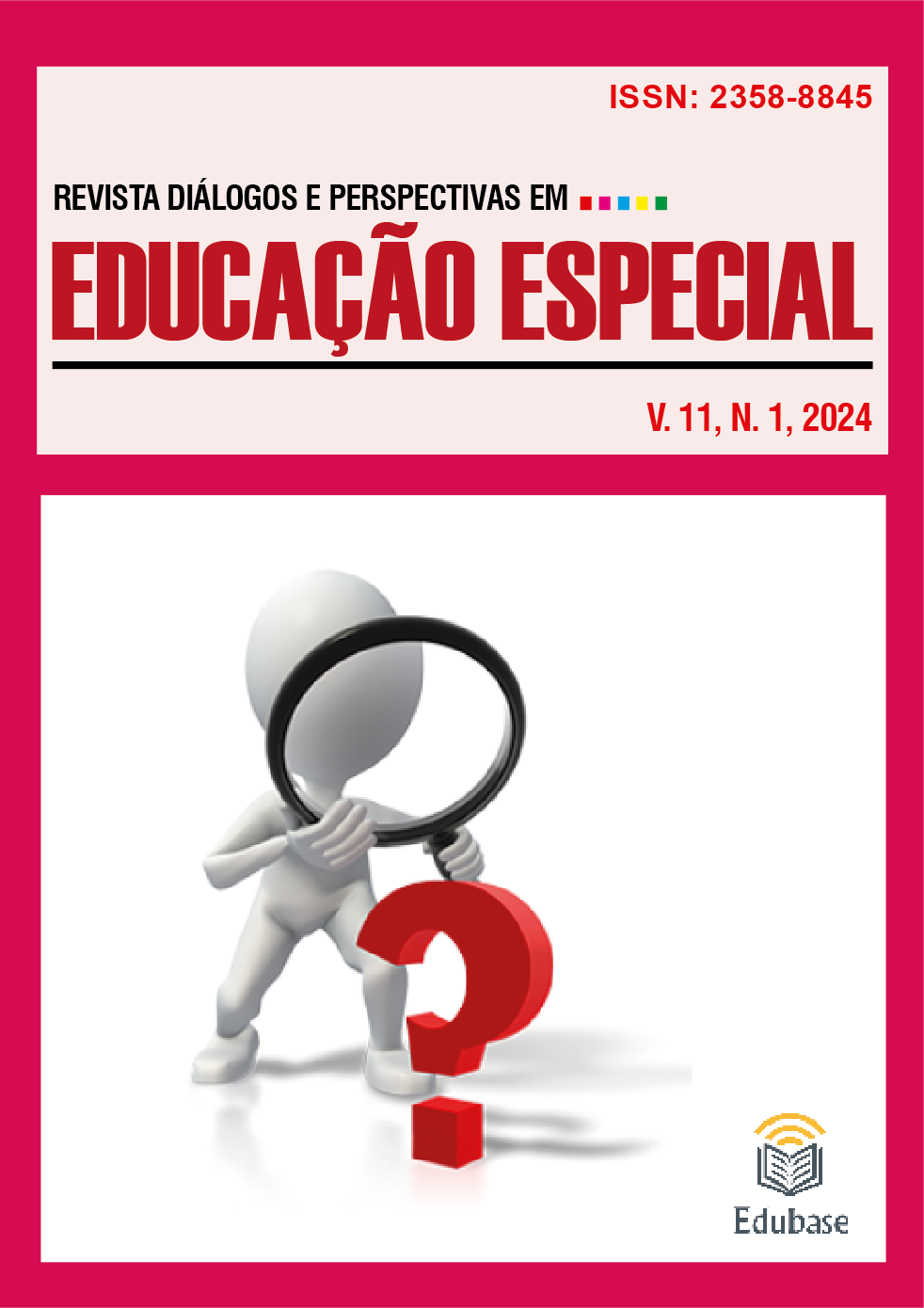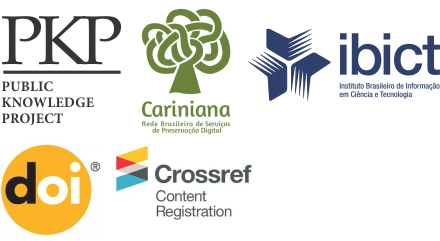Sensory processing and engagement of autistic children in childhood routines
DOI:
https://doi.org/10.36311/2358-8845.2024.v11n1.e0240005Keywords:
Autism Spectrum Disorder., Engagement in childhood., Occupational Therapy., Sensory Integration., Sensory Processing.Abstract
ABSTRACT: Background: Occupations constitute a foundation of human existence, however, the impairment of skills in processing sensory information can impact the engagement of children diagnosed with Autism Spectrum Disorder (ASD). Objective: to investigate the relationship between sensory processing and the engagement of autistic children with 2 to 5 years old in their routines. Method: a quantitative correlational study was carried out. Caregivers responses were collected through an online survey, employing a chain-referral sampling method with two questionnaires, the SPM-P (Sensory Processing Measure - Preschool - Home Form) and the CEQ (Children's Engagement Questionnaire). Results: a total of 56 respondent families [30 families with ASD children and 26 with typically developing (TD) children] were obtained. A correlation and multiple regression analysis identified that the final scores for sensory processing and engagement correlated inversely in ASD and TD children, and that ASD diagnosis and impaired Motor Planning and Ideas significantly reduced engagement, while higher age and schooling incresead it. Conclusion: we observed that the use of strategies that increase the child's engagement in their routines is essential to promote the acquisition of new skills for participation in daily life.
Downloads
Metrics
References
REFERENCES
ABELENDA, Judith; MAILLOUX, Zoe; ROLEY, Susanne Smith. Dyspraxia in Autism Spectrum Disorders: evidence and implications. Sensory Integration Special Interest Section Quarterly, v. 38, n. 3, 2015.
AMERICAN PSYCHIATRIC ASSOCIATION [APA]. DSM-5: Manual diagnóstico e estatístico de transtornos mentais. 5ª ed. Porto Alegre: Artmed, 2014.
ASHBURNER, Jill; ZIVIANI, Jenny; RODGER, Sylvia. Sensory Processing and Classroom Emotional, Behavioral, and Educational Outcomes in Children With Autism Spectrum Disorder. Am. J. Occup. Therapy, v. 62, n. 5, 2008. DOI: 10.5014/ajot.62.5.564.
AYRES, Jean. La Integración Sensorial y el niño. Traducción: Teresa Carmona Lobo. México: Trillas, 1998.
BETTS, Jennifer; MCKAY, Jenny; MARUFF, Paul; ANDERSON, Vicki. The development of sustained attention in children: The effect of age and task load. Child Neuropsychol., v. 12, n. 3, 2006. DOI: 10.1080/09297040500488522.
CARPENTER, Barry; EGERTON, Jo; COCKBILL, Beverley; BLOOM, Tamara; FOTHERINGHAM, Jodie; RAWSON, Hollie; THISTLETHWAITE, Jane. Engaging Learners with Complex Learning Difficulties and Disabilities: a resource book for teachers and teaching assistants. (1st ed.). London: Routledge, 2015.
CHAMAK, Brigitte; BONNIAU, Beatrice; JAUNAY, Emmanuel; COHEN, David. What can we learn about autism from autistic persons? Psychotherapy and psychosomatics, v. 77, n. 5, 2008. DOI: 10.1159/000140086.
CHARMAN, Tony. Why is joint attention a pivotal skill in autism? Phil. Trans. R. Soc. Lond. B., v. 358, n. 1430, 2003. DOI: 10.1098/rstb.2002.1199.
DAHLGREN, Sven Olof; GILLBERG, Christopher. Symptoms in the first two years of life: A preliminar population study of infantile autism. European Archives of Psychiatry & Neurological Sciences, v. 238, n. 3, 1989. DOI: 10.1007/BF00451006.
DOWELL, Lauren R.; MAHONE, E. Mark.; MOSTOFSKY, Stewart H. Associations of postural knowledge and basic motor skill with dyspraxia in autism: implication for abnormalities in distributed connectivity and motor learning. Neuropsychology, v. 23, n. 5, 2009. DOI: 10.1037/a0015640.
DZIUK, M. A.; LARSON, J. C. Gidley; APOSTU, A.; MAHONE, E. Mark.; DENCKLA, Martha Bridge; MOSTOFSKY, Stewart H. Dyspraxia in autism: association with motor, social, and communicative déficits. Dev. Med. Child. Neurol., v. 49, n. 10, 2007. DOI: 10.1111/j.1469-8749.2007.00734.x.
ECKER, Cheryl; PARHAM, L. Diane. Sensory Processing Measure-Preschool (SPM-P) Home Form. Western Psychological Services, 2010.
FIOCRUZ. Saúde mental e atenção psicossocial na pandemia Covid-19: crianças na pandemia Covid-19. 2020. Disponível em: https://www.arca.fiocruz.br/handle/icict/41713. Acesso em: 28 nov. 2021.
FONSECA. Vitor da. Manual de Observação Psicomotora: significação psiconeurológica dos fatores psicomotores. Rio de Janeiro: Wak, 2012.
GENTIL-GUTIÉRREZ, Ana; CUESTA-GÓMEZ, José Luis.; RODRÍGUEZ-FERNÁNDEZ, Paula; GONZÁLEZ-BERNAL, Jerónimo Javier. Implication of the sensory environment in children with Autism Spectrum Disorder: perspectives from school. International Journal of Environmental Research and Public Health, v. 18, n. 14, 2021. DOI: 10.3390/ijerph18147670.
GOMES, Maria Dulce; FERNANDES, Paulo; DIXE, Maria Anjos; PINTO, Branca.; SOUSA, Madalena; BATISTA, Sara. Adaptação da Sensory Processing Measure – Preschool (SPM-P) para a língua e cultura Portuguesa. Research and Networks in Heatlh, v. 1, n. 2, 2016.
GUTIÉRREZ, Juliana; CHANG, Megan; BLANCHE, Erna Imperatore. Funciones sensoriales en niños menores de 3 años diagnosticados con trastorno del espectro autista (TEA). Revista Chilena de Terapia Ocupacional, v. 16, n. 1, 2016. DOI: 10.5354/0719-5346.2016.41946.
HAZEN, Eric P.; STORNELLI, Jennifer L.; O’ROURKE, Julia A.; KOESTERER, Karmen; MCDOUGLE, Christopher J. Sensory symptoms in autism spectrum disorders. Harvard review of Psychiatry, v. 22, n. 2, 2014. DOI: 10.1097/01.hrp.0000445143.08773.58.
HOCHHAUSER, Michal; ENGEL-YEGER, Batya. Sensory processing abilities and their relation to participation in leisure activities among children with high-functioning autism spectrum disorder (HFASD). Research in Autism Spectrum Disorders, v. 4, n. 4, 2010. DOI: 10.1016/j.rasd.2010.01.015.
JIAO, Wen Yan.; WANG, Lin Na; LIU, Juan; FANG, Shuan Feng.; JIAO, Fu Yong.; PETTOELLO-MANTOVANI, Massimo; SOMEKH, Eli. Behavioral and Emotional Disorders in Children during the Covid-19. Epidemic. J. Pediatr., v. 221, 2020. DOI: 10.1016/j.jpeds.2020.03.013.
JONES, Emily A. Establishing response and stimulus classes for initiating joint attention in children with autism. Research in Autism Spectrum Disorders, v. 3, n. 2, 2009. DOI: 10.1016/j.rasd.2008.08.004.
KANE, Audrey E. Sensory modulation disorder: Impact on coping and occupational performance. 2013. 165 f. [Dissertação de Mestrado] – Virginia Commonwealth University, Virginia, 2013.
LARSON, Jennifer C. Gidley; BASTIAN, Amy J.; DONCHIN, Opher; SHADMEHR, Reza; MOSTOFSKY, Stewart H. Acquisition of internal models of motor tasks in children with autism. Brain, v. 131, n. 11, 2008. DOI: 10.1093/brain/awn226.
LEWNARD, Joseph A.; LO, Nathan C. Scientific and ethical basis for social-distancing interventions against Covid-19. The Lancet Infeccious Diseases. v. 20, n. 6, 2020. DOI: 10.1016/S1473-3099(20)30190-0.
LIN, Ling-Yi. Activity Participation and Sensory Processing Patterns of Preschool-Age Children With Autism Spectrum Disorder. American Journal of Occupational Therapy, v. 74, n. 6, 2020. DOI: 7406345010p1-7406345010p7.
LITTLE, Lauren M.; DEAN, Evan; TOMCHEK, Scott.; DUNN, Winnie. Sensory processing patterns in autism, attention deficit hyperactivity disorder, and typical development. Physical & occupational therapy in Pediatrics, v. 38, n. 3, 2018. DOI: 10.1080/01942638.2017.1390809.
MACLENNAN, Keren; ROACH, Lauren.; TAVASSOLI, Teresa. The relationship between sensory reactivity differences and anxiety subtypes in autistic children. Autism Research, v. 13, n. 5, 2020. DOI: 10.1002/aur.2259.
MACNEIL, Lindsey K.; MOSTOFSKY, Stewart H. Specificity of Dyspraxia in Children With Autism. Neuropsychology, v. 26, n. 2, 2012. DOI: 10.1037/a0026955.
MARCO, Elysa J.; HINKLEY, Leighton B.; HILL, Susanna S.; NAGARAJAN, Srikantan S. Sensory processing in autism: a review of neurophysiologic findings. Pediatric Research, v. 69, n. 8, 2011. DOI: 10.1203/pdr.0b013e3182130c54.
MCWILLIAM, Robin A.; YOUGGREN, Naomi. Measure of Engagement, Independence, and Social Relationships – MEISR Manual. Baltimore: Brookes Publishing, 2019.
MCWILLIAM, Robin A.; CASEY, Amy M. Engagement of every child in the preschool classroom. Baltimore: Brookes Publishing, 2008.
MCWILLIAM, Robin A., BAILEY, Donald B. Effects of classroom social structure and disability on engagement. Topics in Early Childhood Special Education, v. 15, n. 2, 1995.
MILLER KUHANECK, Heather; ECKER, Cheryl.; PARHAM, L. Diane.; HENRY, Diana A.; GLENNON, Tara J. Sensory Processing Measure - Preschool (SPM-P): Manual. Canadá: Western Psychological Services, 2010.
MIOT, Hélio Amante. Análise de correlação em estudos clínicos e experimentais. J. Vasc. Bras., v. 17, n. 4, 2018. DOI: 10.1590/1677-5449.174118.
NEUFELD, Janina; HEDEROS ERIKSSON, Lisa; HAMMARSTEN, Richard; LUNDIN REMNÉLIUS, Karl; TILLMANN, Julian; ISAKSSON, Johan; BÖLTE, Sven. The impact of atypical sensory processing on adaptive functioning within and beyond autism: the role of familial factors. Autism, v. 25, n. 8, 2021. DOI: 10.1177/13623613211019852.
OLIVEIRA, P. L. Processamento sensorial e alimentação em crianças com desenvolvimento típico e com transtorno do espectro autista. 2019. 77 f. [Dissertação de Mestrado] – Universidade Federal de Santa Maria, Rio Grande do sul, 2019. Disponível em: https://repositorio.ufsm.br/handle/1/19742. Acesso em: 28 nov. 2021.
PAIVA, Eny Dórea; SILVA, Lucina Rodrigues da; MACHADO, Maria Estela Diniz; AGUIAR, Rosane Cordeiro Burla de.; GARCIA, Karina Rangel da Silva; ACIOLY, Paloma Gonçalves Martins. Comportamento infantil durante o distanciamento social na pandemia de Covid-19. REBEn Rev. Bras. Enferm. v. 74 (Suppl. 1), 2021. DOI: 10.1590/0034-7167-2020-0762.
PÉREZ-FONSECA, Rebeca; BURGUILLOS-TORRES, Germán E.; CASTILLO-VELÁSQUEZ, Victoria G.; MORENO-ZULETA, Natalia; FONSECA-ANGULO, Rosa I.; BLUMTRITT, Cesar.; GARCÍA-JIMÉNEZ, Rafael. Sensory profile in children with autism disorder and children with typical development. Revista Mexicana de Neurociência, v. 20, n. 5, 2019. DOI: 10.24875/rmn.m19000019.
PINTO, Ana Isabel. QEC: Questionário de Envolvimento de Crianças. Coleção Inéditos IDECCA. Repositório Aberto da Universidade do Porto. 2013. Disponível em: https://repositorio-aberto.up.pt/. Acesso em: 28 nov. 2021.
POSAR, Annio; VISCONTI, Paola. Sensory abnormalities in children with autism spectrum disorder. Jornal de Pediatria, v. 94, n. 4, 2018. DOI: 10.1016/j.jped.2017.08.008.
REDA, Mona; MEGUID, Nagwa A.; EID, Ola M.; HUSSEIN, Fatma; ELALFY, Dina Y. Study of sensory processing deficits in autism spectrum disorder symptom triad: an Egyptian sample. Middle East Current Psychiatry, v. 28, n. 1, 2021. DOI: 10.1186/s43045-020-00082-5.
ROLEY, Susanne Smith; MAILLOUX, Zoe; MILLER-KUHANECK, Heather; GLENNON, Tara J. Understanding Ayres' Sensory Integration. OT Practice, v. 12, n. 7, 2007. Disponível em: http://digitalcommons.sacredheart.edu/ot_fac. Acesso em: 28 nov. 2021.
SANTOS, Aline Diniz dos; SILVA, Júlia Kamers da. O impacto do isolamento social no desenvolvimento cognitivo e comportamental infantil. Res. Soc. Dev., v. 10, n. 9, 2021. DOI: 10.33448/rsd-v10i9.18218.
SANZ CERVERA, Pilar; FERNÁNDEZ ANDRÉS, Maria Inmaculada; PASTOR CEREZUELA, Gemma; PUCHOL FRAILE, Irene; HERRÁIZ LLONGO, Eva. Relación entre el procesamiento sensorial y la severidad de la sintomatología en una muestra de niños con TEA. Int. J. Dev. Educ. Psychol., v. 3, n. 1, 2014. DOI: 10.17060/ijodaep.2014.n1.v3.513.
SCHAAF, Roseann C.; COHN, Ellen S.; BURKE, Janice; DUMONT, Rachel; MILLER, Amy; MAILLOUX, Zoe. Linking sensory factors to participation: establishing intervention goals with parents for children with autism spectrum disorder. American Journal of Occupational Therapy, v. 69, n. 5, 2015. DOI: 10.5014/ajot.2015.018036.
SCHAAF, Roseann C.; TOTH-COHEN, Susan; JOHNSON, Stephanie L.; OUTTEN, Gina; BENEVIDES, Teal W. The everyday routines of families of children with autism: examining the impact of sensory processing difficulties on the family. Autism, v. 15, n. 3, 2011. DOI: 10.1177/1362361310386505.
SERRADA-TEJEDA, Sergio; SANTOS-DEL-RIEGO, Sergio; MAY-BENSON, Teresa A.; PÉREZ-DE-HEREDIA-TORRES, Marta. Influence of Ideational Praxis on the development of play and adaptive behavior of children with Autism Spectrum Disorder: a comparative analysis. Int. J. Environ. Res. Public Health., v. 18, n. 11, 2021. DOI: 10.3390/ijerph18115704.
SUAREZ, Michelle A. Sensory processing in children with autism spectrum disorders and impact on functioning. Pediatric Clinics, v. 59, n. 1, 2012. DOI: 10.1016/j.pcl.2011.10.012.
TAVASSOLI, Teresa; BELLESHEIM, Katherine; SIPER, Paige M.; WANG, A. Ting; HALPERN, Danielle; GORENSTEIN, Michelle et al. Measuring sensory reactivity in autism spectrum disorder: application and simplification of a clinician-administered sensory observation scale. Journal of Autism and Developmental Disorders, v. 46, n. 1, 2016. DOI: 10.1007/s10803-015-2578-3.
THYE, Melissa D.; BEDNARZ, Haley M.; HERRINGSHAW, Abbey J.; SARTIN, Emma B.; KANA, Rajesh K. The impact of atypical sensory processing on social impairments in autism spectrum disorder. Developmental Cognitive Neuroscience, v. 29, 2018. DOI: 10.1016/j.dcn.2017.04.010.
WHO. Meeting report: autism spectrum disorders and other developmental disorders: from raising awareness to building capacity. World Health Organization, Geneva, Switzerland. 2013. https://apps.who.int/iris/handle/10665/103312.
Downloads
Published
How to Cite
Issue
Section
License
Copyright (c) 2023

This work is licensed under a Creative Commons Attribution 4.0 International License.
- Os trabalhos publicados na RDPEE são de responsabilidade exclusiva de seus autores. Os autores concedem à revista o direito de primeira publicação, com o trabalho simultaneamente licenciado sob a Atribuição-CC BY, que permite a distribuição, remixagem, adaptação e criação a partir do trabalho com reconhecimento da autoria e publicação inicial nesta revista.
- Os autores consentem, que seus artigos podem ser incorporados pela RDPEE em indexadores e bancos de dados atuais existentes ou a existir no futuro; os titulares destes bancos podem reproduzir, transmitir e distribuir os textos, no todo ou em parte, sob qualquer forma ou meio de transmissão eletrônica existente ou desenvolvida no futuro.
Qualis Capes (2017-2020)
Educação: B1




